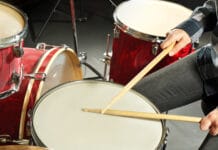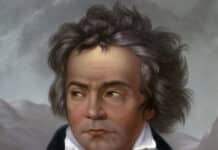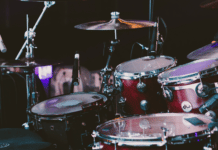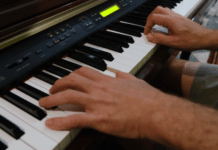Walt Disney’s original Fantasia and its music have become instantly recognizable since the film’s debut in 1940. The film’s magic is rightly celebrated for its groundbreaking animation, but it’s inseparable from the music. In some cases, the music follows the original composer’s visual concept, and other times there’s a sharp departure. Either way, these pieces are unforgettable.
Toccata and Fugue in D Minor, BWV 565 – J.S. Bach
This piece, conducted here by Leopold Stokowski, is one of Bach’s best-known works. It’s instantly recognizable even to audiences unfamiliar with classical music. Originally composed as an organ piece, it’s arranged for orchestra in this performance. It sets the tone for the entire film, featuring closely linked music and visuals. The abstract lines and splashes of color follow the flow of the music’s ups and downs to a soaring conclusion.
The Nutcracker Suite, Op. 71a – Pyotr Ilyich Tchaikovsky
The visual connection with the “Dance of the Sugarplum Fairy” is more literal than other sequences of Fantasia music.
This selection is from a larger work, Tchaikovsky’s ballet Nutcracker Suite. It’s instantly familiar as a seasonal Christmas piece, which was the original intent. The animation here isn’t holiday-themed, but the delicate flowers and fairies are a good match with the tinkling melody of the music.
The Sorcerer’s Apprentice – Paul Dukas
This 1897 piece bears the subtitle “Scherzo After a Ballad by Goethe,” suggesting a serious literary reference. In the scheme of Fantasia’s music, the story is more light-hearted.
In the role of the sorcerer’s apprentice, Mickey Mouse decides to lighten his workload. He uses the sorcerer’s hat to animate household objects to do his chores but gets carried away with its power. He soon finds himself unable to stop an army of brooms as they dump buckets of water everywhere. Only the sorcerer’s return saves Mickey.
Rite of Spring – Igor Stravinsky
Stravinksy’s The Rite of Spring and the ballet it accompanied debuted to furious controversy in 1913. The music’s savage tones and jarring choreography sparked near-riots on its opening night in Paris. The story depicted in the ballet is of an ancient pagan rite in which a young sacrificial victim dances herself to death. Fantasia’s music dramatization has no human violence. Instead, we see violent cosmic forces shaping our planet and then giving it life. The bitter struggles of evolution play out on a grander scale as we see the rise and extinction of the dinosaurs.
Fun Fact: The Jam Session Sequence is a brief musical interlude by Philadelphia Orchestra that happens while the orchestra waits for the presenter to return from an intermission in filming. Unlike most Fantasia music, it’s a playful, jazzy selection. There’s no animation here, just an orchestra trying to let off a bit of steam between weightier symphonic pieces.
Symphony No. 6 (‘Pastoral’) Op. 680 – Ludwig van Beethoven
Beethoven’s famed “Pastoral” symphony forms the perfect backdrop for Disney’s trademark animation. The subject matter is lighter than expected for a “serious” classical work. Baby unicorns, satyrs, and pegasi frolic in a pastel-colored pastoral scene. Two proud parents take their fledgling foals out on their first flight. The winged horses then mimic swans as they land on the surface of a lake. They splash and swim through a pleasant landscape, and our view focuses on a bright flower floating away from the closing scene.
Fun Fact: In 2014, Disney, in collaboration with Harmonix, released Disney Fantasia: Music Evolved Songs, a musical motion game for Xbox One and Kinect for Xbox 360. The game has remixes of classic songs such as Vivaldi’s The Four Seasons: Winter, 1st classic and Tchaikovsky’s The Nutcracker Medley. There are also modern songs from Avicii, Cee Lo Green, Drake, Lady Gaga, Nicki Minaj, Rihanna, Bruno Mars, White Stripes, and Lady Gaga.
Dance of the Hours – Amilcare Ponchielli
This comical sequence from Ponchielli’s 1876 opera La Gioconda is pure, delightful silliness. The brisk, skittering tune is a good fit for the animation as a crocodile suitor courts his hippo beloved. What starts as a slow dance becomes a wacky chase scene as other crocodiles join in and other hippos thwart their maneuvers. Elephants and ostriches soon become involved in the caper as the dancing culminates in a long dance line of animals.
A Night on Bald Mountain (1867) – Modest Mussorgsky (as Modeste Moussorgsky)
This piece by the Russian composer Modest Mussorgsky is said to be a musical representation of a witches’ sabbath gathering on St. John’s Eve (June 23). The Disney animation stays close to the original intent of the piece. Mussorgsky’s eerie, often discordant music is the perfect soundtrack as we see demons, witches, and spirits take flight. The music reaches a fever pitch as they congregate on Bald Mountain and do a frenzied dance around a towering demonic figure. For all their menace, the first light of dawn sends the horrible host back to the underworld. A church bell sounds in the distance dispelling the last traces of the ghastly scene as morning arrives, and the scene transitions seamlessly to the next piece.
Ave Maria, Op. 52 No. 6 (1825) – Franz Schubert
This piece is one of the most famous pieces of devotional music and is still a favorite at weddings and funerals. After the frenzied menace of Night on Bald Mountain, the serene beauty of this piece draws the audience to the conclusion of Fantasia. We see cloaked figures bearing lights and walking through a forest at daybreak. The scene is not explicitly religious, but the high tree branches form arches like a cathedral’s. The figures’ passage into darkness suggests a passage into death. As shafts of light pierce the darkness, our view opens onto a picture of paradise, shown as a garden at sunrise.
A Classic of Screen and Orchestra
Many people’s first exposure to classical music comes from Fantasia’s music. Sometimes it’s their only exposure, but the music is unforgettable. The animation is also legendary, ranging from dancing hippos to Mickey Mouse over his head to quiet meditations on the afterlife. Even though none of the music selections were written specifically for the film, it fits the visuals so well that it’s hard to separate the two.
What’s your favorite Disney Fantasia music? Let us know in the comments.
Table of Contents






